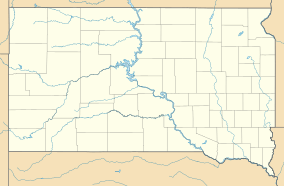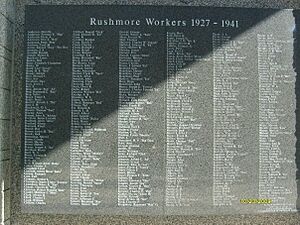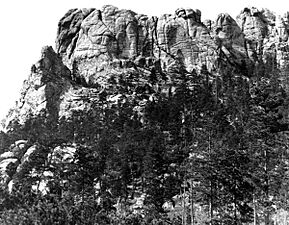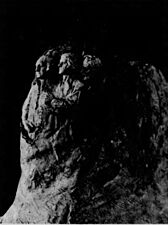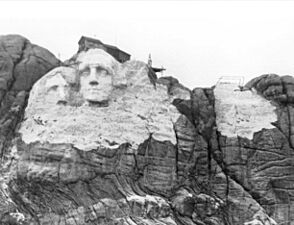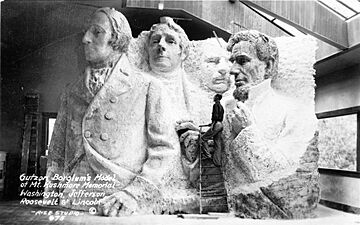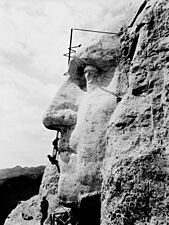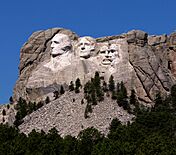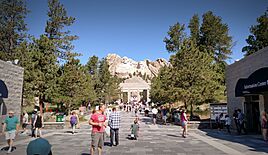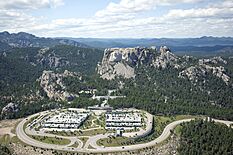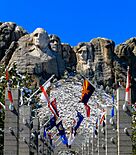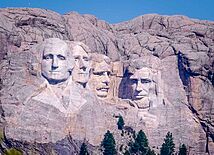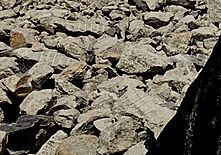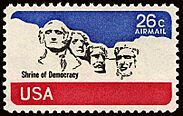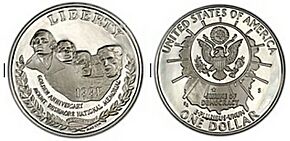Mount Rushmore facts for kids
Quick facts for kids Mount Rushmore National MemorialShrine of Democracy Tȟuŋkášila Šákpe |
|
|---|---|
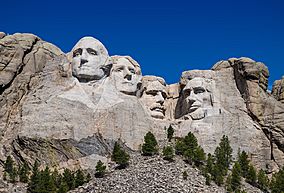
Mount Rushmore features Gutzon Borglum's sculpted heads of George Washington, Thomas Jefferson, Theodore Roosevelt and Abraham Lincoln (left to right).
|
|
| Location | Pennington County, South Dakota |
| Nearest city | Keystone, South Dakota |
| Area | 1,278 acres (5.17 km2) |
| Authorized | March 3, 1925 |
| Visitors | 2,440,449 (in 2022) |
| Governing body | National Park Service |
| Website | |
|
Mount Rushmore National Memorial
|
|
| Built | 1927–1941 |
| Architect | Gutzon and Lincoln Borglum |
| NRHP reference No. | 66000718 |
| Added to NRHP | October 15, 1966 |
The Mount Rushmore National Memorial is a huge sculpture carved into the side of a mountain in the Black Hills of South Dakota, United States. It's often called the Shrine of Democracy. The sculpture shows the faces of four important United States presidents: George Washington, Thomas Jefferson, Theodore Roosevelt, and Abraham Lincoln. Each face is about 60 feet (18 meters) tall!
A sculptor named Gutzon Borglum designed this amazing artwork. He worked on it from 1927 to 1941, with help from his son, Lincoln Borglum. These presidents were chosen to represent important parts of America's story: its birth, growth, development, and how it stayed together.
Mount Rushmore is a very popular place. More than two million people visit the memorial park each year. The mountain itself is 5,725 feet (1,745 meters) above sea level.
The idea for the sculpture came from Doane Robinson, a historian from South Dakota. He wanted to attract more tourists. Robinson first thought about carving heroes of the American West, like Lewis and Clark or Sacagawea. But Borglum decided to carve the four presidents instead.
A U.S. senator from South Dakota, Peter Norbeck, helped get money from the government for the project. Building started in 1927. The presidents' faces were finished between 1934 and 1939. Gutzon Borglum passed away in 1941, and his son Lincoln took over. The original plan was to carve the presidents from head to waist. But there wasn't enough money, so the carving stopped on October 31, 1941. Only Washington's sculpture has details below his chin.
The land where Mount Rushmore is carved was once part of the Great Sioux Nation. It was taken from them in the 1870s. The Sioux people still want their land back. In 1980, a court ruled that the land was taken unfairly. The court offered the tribe money, which has grown to over a billion dollars. But the Sioux have refused the money. They continue to ask for their land to be returned.
Contents
The Story of Mount Rushmore
From Sacred Mountain to Famous Monument
The Black Hills (called Pahá Sápa by the Lakota people) and Mount Rushmore are very important to Native American tribes like the Lakota Sioux, Arapaho, and Cheyenne. For hundreds of years, they used this area for prayer, gathering food, and finding materials for building and medicine.
The Lakota people called the mountain "Six Grandfathers" (Tȟuŋkášila Šákpe). This name honored their ancestors and the six directions (north, south, east, west, above, and below). In 1868, the U.S. government signed a treaty, giving the Sioux exclusive use of the Black Hills forever.
However, in the 1870s, gold was discovered in the Black Hills. This led to many settlers moving into the area. In 1877, the U.S. government broke the treaty and took control of the land.
The mountain got its new name, "Mount Rushmore," in 1884 or 1885. A New York lawyer named Charles E. Rushmore visited the area. When he asked his guide the mountain's name, the guide joked that it didn't have one and would now be named after Rushmore. The name stuck and became official in 1930.
Planning the Big Carving
By the 1920s, South Dakota was a popular place for tourists. Doane Robinson, a historian, wanted to make it even more popular. He heard about a large carving project in Georgia and thought South Dakota should have something similar. He wanted a monument that showed the "triumph of western civilization."
Robinson asked Gutzon Borglum, the sculptor from the Georgia project, to visit. Borglum came to South Dakota in 1924. He first thought about carving the Needles, which are tall, thin granite pillars. But these rocks were too fragile for carving. Also, some people protested carving the Needles because of environmental and religious reasons.
In 1925, Borglum saw Mount Rushmore. He decided it was the perfect spot because it was grand and faced southeast, getting lots of sunlight.
Borglum didn't like Robinson's idea of carving Old West heroes. Instead, he chose four U.S. presidents: George Washington, Thomas Jefferson, Abraham Lincoln, and Theodore Roosevelt. He said these presidents represented important moments in American history.
However, the Lakota and other local Native American groups were against the monument. They saw it as disrespecting their sacred lands. They also pointed out the presidents' past actions against Native Americans. For these tribes, the monument became a symbol of losing their sacred lands and the unfair treatment they received from the U.S. government.
Senator Norbeck and Congressman William Williamson helped get permission to use federal land for the project. Getting state support was harder, but it finally passed. Money from private donors came slowly. President Calvin Coolidge promised federal funding, and in 1929, Congress approved up to $250,000 in matching funds.
Building the Presidents
From October 4, 1927, to October 31, 1941, Gutzon Borglum and 400 workers carved the huge faces. They used dynamite to remove large amounts of rock. Then, workers drilled many small holes close together to remove smaller pieces by hand. About 450,000 tons of rock were blasted off the mountain.
Originally, Thomas Jefferson's face was started to the right of Washington. But the rock there wasn't good. So, they blasted away that part and carved his face to Washington's left instead.
The main carver was Luigi Del Bianco, a skilled stonemason from Italy. He was chosen because he was very good at making the faces look real and show emotion.
In 1933, the National Park Service took over Mount Rushmore. They helped improve the area, like upgrading the tram for workers. Washington's face was finished and dedicated on July 4, 1934. Jefferson's face was dedicated in 1936, and Lincoln's in 1937. In 1939, Theodore Roosevelt's face was dedicated.
Gutzon Borglum passed away in March 1941. His son, Lincoln Borglum, finished the project. The total cost of the project was about $990,000. No workers died during the carving, which was a huge achievement for such a dangerous job. The last remaining carver, Nick Clifford, died in 2019 at age 98.
Later Changes and Ideas
The first visitor center was built in 1957. Later, in 1998, new and improved visitor facilities were completed. These included a Visitor Center, the Lincoln Borglum Museum, and the Presidential Trail.
Mount Rushmore was added to the National Register of Historic Places in 1966. In 1973, an essay about U.S. history by a student named William Andrew Burkett was placed on a bronze plate at the monument. In 1991, President George H. W. Bush officially dedicated Mount Rushmore.
In 2004, Gerard Baker became the first Native American superintendent of the park. He wanted to share more stories about the area, not just focus on the four presidents.
People have sometimes suggested adding more faces to Mount Rushmore. In 1937, there was a bill to add Susan B. Anthony, a women's rights activist, but it didn't pass. Sculptors later said the rock wasn't suitable for more carvings. Some have suggested adding John F. Kennedy or Ronald Reagan. Even Donald Trump has joked about his face being added.
Visiting Mount Rushmore
| Year | Visitors |
|---|---|
| 1941 | 393,000 |
| 1950 | 740,499 |
| 1960 | 1,067,000 |
| 1970 | 1,965,700 |
| 1980 | 1,284,888 |
| 1990 | 1,671,673 |
| 2000 | 1,868,876 |
| 2010 | 2,331,237 |
| 2020 | 2,074,986 |
Tourism is a huge industry in South Dakota, and Mount Rushmore is the most popular place to visit. Over 2 million people came to the park in 2012.
Mount Rushmore is famous because it's so unique. There's no other place like it! Unlike many monuments in big cities, Mount Rushmore is also surrounded by beautiful wilderness.
In the 1950s and 1960s, a Lakota Sioux elder named Ben Black Elk (son of the famous medicine man Black Elk) was known as the "Fifth Face of Mount Rushmore." He would pose for photos with thousands of tourists every day in his traditional clothing.
Hidden Secrets and Caretakers
The Hall of Records
Gutzon Borglum originally wanted to create a large "Hall of Records" inside the mountain. This secret room would hold important American historical documents and artifacts. He started carving a tunnel, but work stopped in 1939 to focus on the faces.
In 1998, a special room was built inside the cave. It holds 16 enamel panels with information about Mount Rushmore and copies of the documents Borglum wanted to save. These panels are kept safe in a teakwood box inside a titanium vault.
Keeping the Monument Safe
The National Park Service takes care of Mount Rushmore. Mountain climbers check the monument every year to find and seal any cracks. This helps protect the carvings from water damage.
The monument isn't cleaned regularly to remove moss and other growths because of budget limits. However, in 2005, a German company cleaned it for free using high-pressure water. Modern sealants are now used in the cracks, replacing Borglum's original mixture.
Electronic devices were installed in 1998 to track any tiny movements in the sculpture. In 2009, the site was digitally scanned. This created a very detailed 3D model to help with future conservation efforts.
Nature Around Mount Rushmore
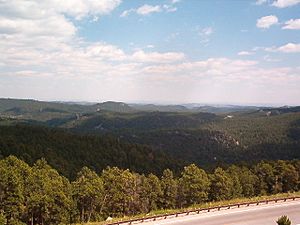
The plants and animals at Mount Rushmore are similar to those found in the rest of the Black Hills.
Animals of the Black Hills
Many birds fly around Mount Rushmore and nest on its ledges. These include turkey vultures, golden eagles, bald eagles, and swallows. Smaller birds like woodpeckers live in the surrounding pine forests.
On the ground, you might see mice, chipmunks, squirrels, skunks, and raccoons. Larger animals like coyotes, bighorn sheep, bobcats, and elk also live here. You might even spot American bison.
Several types of frogs and snakes live in the area. The streams have fish like longnose dace and brook trout. The mountain goats you might see are not native. They are descendants of goats given to a nearby park in 1924 that later escaped.
Plants of the Black Hills
Most of the monument is surrounded by ponderosa pine trees. Other trees include bur oak and cottonwood. There are also nine types of shrubs and many wildflowers, like snapdragons and sunflowers. As you go higher up the mountain, there are fewer plants.
Weather and Water
The area gets about 18 inches (457 mm) of rain each year. This is enough to support all the plants and animals. Trees and other plants help control water runoff. Natural springs and dikes also help collect water, providing drinking spots for animals.
In 2016, a study found high levels of a chemical called perchlorate in the water. This was likely caused by fireworks displays that happened on Independence Day from 1998 to 2009. These fireworks also caused at least 27 forest fires around Mount Rushmore during that time.
Forest fires happen naturally in the ponderosa forests about every 27 years. Most of these are small ground fires that help clear out dead plants.
The Mountain's Story
How the Mountain Was Formed
Mount Rushmore is mostly made of granite, a very hard rock. The mountain is part of a larger granite formation in the Black Hills. This granite formed 1.6 billion years ago when hot, melted rock pushed into older rocks. You can see lighter streaks on the presidents' foreheads; these are from different types of rock called pegmatite dikes.
Over millions of years, the Black Hills were pushed up into a dome shape. Then, wind and water slowly wore away the softer rocks, leaving the hard granite of Mount Rushmore exposed. You can still see some darker, softer rock just below Washington's sculpture.
Why This Rock?
Borglum chose Mount Rushmore for several reasons. The granite is smooth and fine-grained, which is good for carving. It's also very strong and wears away very slowly, only about 1 inch (25 mm) every 10,000 years. This means the sculpture will last a very long time.
The mountain is 5,725 feet (1,745 meters) high, making it a grand location. And because it faces southeast, the carvers had sunlight for most of the day.
It's not possible to add another president to the memorial. The rock around the existing faces isn't suitable for more carving. Also, adding more could make the existing carvings unstable.
Climate of Mount Rushmore
Mount Rushmore has a climate with warm summers and cold, dry winters. The wettest months are May and June. In the summer, you might experience quick but strong thunderstorms in the afternoons.
| Climate data for Mount Rushmore National Memorial (1991–2020 normals, extremes 1962–present) | |||||||||||||
|---|---|---|---|---|---|---|---|---|---|---|---|---|---|
| Month | Jan | Feb | Mar | Apr | May | Jun | Jul | Aug | Sep | Oct | Nov | Dec | Year |
| Record high °F (°C) | 70 (21) |
68 (20) |
78 (26) |
85 (29) |
93 (34) |
99 (37) |
100 (38) |
99 (37) |
97 (36) |
86 (30) |
75 (24) |
68 (20) |
100 (38) |
| Mean maximum °F (°C) | 57.8 (14.3) |
57.3 (14.1) |
65.2 (18.4) |
72.9 (22.7) |
81.5 (27.5) |
89.2 (31.8) |
92.7 (33.7) |
90.9 (32.7) |
87.2 (30.7) |
77.0 (25.0) |
65.4 (18.6) |
57.2 (14.0) |
94.0 (34.4) |
| Mean daily maximum °F (°C) | 36.8 (2.7) |
36.3 (2.4) |
44.2 (6.8) |
50.2 (10.1) |
59.6 (15.3) |
71.1 (21.7) |
78.7 (25.9) |
77.5 (25.3) |
69.1 (20.6) |
55.0 (12.8) |
44.4 (6.9) |
36.6 (2.6) |
55.0 (12.8) |
| Daily mean °F (°C) | 27.8 (−2.3) |
27.3 (−2.6) |
34.8 (1.6) |
41.0 (5.0) |
50.6 (10.3) |
61.5 (16.4) |
68.9 (20.5) |
67.8 (19.9) |
59.4 (15.2) |
45.9 (7.7) |
35.7 (2.1) |
28.2 (−2.1) |
45.7 (7.6) |
| Mean daily minimum °F (°C) | 18.8 (−7.3) |
18.4 (−7.6) |
25.4 (−3.7) |
31.8 (−0.1) |
41.5 (5.3) |
51.9 (11.1) |
59.1 (15.1) |
58.0 (14.4) |
49.6 (9.8) |
36.8 (2.7) |
27.0 (−2.8) |
19.8 (−6.8) |
36.5 (2.5) |
| Mean minimum °F (°C) | −5.8 (−21.0) |
−4.2 (−20.1) |
3.8 (−15.7) |
15.3 (−9.3) |
26.9 (−2.8) |
39.8 (4.3) |
48.1 (8.9) |
45.9 (7.7) |
32.2 (0.1) |
17.2 (−8.2) |
6.8 (−14.0) |
−2.2 (−19.0) |
−12.6 (−24.8) |
| Record low °F (°C) | −38 (−39) |
−29 (−34) |
−16 (−27) |
1 (−17) |
14 (−10) |
27 (−3) |
40 (4) |
33 (1) |
19 (−7) |
−4 (−20) |
−12 (−24) |
−31 (−35) |
−38 (−39) |
| Average precipitation inches (mm) | 0.48 (12) |
0.76 (19) |
1.35 (34) |
2.62 (67) |
4.80 (122) |
3.58 (91) |
3.59 (91) |
2.29 (58) |
1.76 (45) |
1.80 (46) |
0.59 (15) |
0.50 (13) |
24.12 (613) |
| Average snowfall inches (cm) | 7.2 (18) |
8.9 (23) |
9.6 (24) |
13.1 (33) |
1.5 (3.8) |
0.2 (0.51) |
0.0 (0.0) |
0.0 (0.0) |
0.9 (2.3) |
4.9 (12) |
6.4 (16) |
6.6 (17) |
59.3 (151) |
| Average precipitation days (≥ 0.01 in) | 5.1 | 6.1 | 6.7 | 9.7 | 13.6 | 13.4 | 12.4 | 10.5 | 7.7 | 7.1 | 4.5 | 4.7 | 101.5 |
| Average snowy days (≥ 0.1 in) | 4.5 | 4.9 | 3.9 | 3.4 | 0.8 | 0.1 | 0.0 | 0.0 | 0.2 | 1.7 | 3.0 | 4.0 | 26.5 |
| Source: NOAA | |||||||||||||
Mount Rushmore in Movies and TV

Mount Rushmore has appeared in many films, comic books, and TV shows. It's often used as a setting for exciting action scenes or as a hidden base. Its most famous appearance is in the 1959 movie North by Northwest, where a chase scene happens on the faces.
In the 2004 film Team America: World Police, it's a secret base. In National Treasure: Book of Secrets (2007), a hidden city is located there. Sometimes, the presidents' faces are changed in movies. In Superman II (1980) and Mars Attacks! (1996), the villains add their own faces to the monument.
Mount Rushmore is also a common target when movies show attacks on famous landmarks. This shows how big a threat is. But in the 2013 movie Nebraska, the monument is shown in a different way. It's criticized for being unfinished, instead of being seen as grand.
The Land Dispute
The Treaty of Fort Laramie (1868) promised the Black Hills to the Lakota people forever. However, the United States took the land after the Great Sioux War of 1876.
In 1971, members of the American Indian Movement protested at the monument. They called it "Mount Crazy Horse." A Lakota holy man, John Fire Lame Deer, placed a prayer staff on top of the mountain. He said it was a symbolic cover over the presidents' faces. This cover would stay until the treaties about the Black Hills were honored.
In 1980, the United States Supreme Court ruled that the Sioux had not been fairly paid for their land in the Black Hills. The court offered $102 million as payment. With interest, this money grew to almost $2 billion by 2021. But the Oglala Lakota Nation and other Indigenous activists have refused the money. They want their lands returned, as promised by the treaties.
Construction on the Crazy Horse Memorial began in 1940 in another part of the Black Hills. This monument is meant to honor Native American leaders and is a response to Mount Rushmore. If finished, it will be much larger than Mount Rushmore. The Crazy Horse Memorial Foundation has refused government money. Its construction is supported by some Lakota chiefs, but it is also a topic of debate among Native American tribes.
Mount Rushmore's Place in History
Borglum called his sculpture the Shrine of Democracy. But because the land was taken from the Lakota people, some critics call it the "Shrine of Hypocrisy."
Mount Rushmore has been honored in many ways. In 1952, the U.S. Post Office released a 3-cent stamp showing the memorial. Another stamp was issued in 1974. In 1991, special coins were made to celebrate the monument's 50th anniversary. The sculpture was also featured on the 2006 South Dakota state quarter.
In music, composer Michael Daugherty wrote a piece called "Mount Rushmore" in 2010. It features each of the four presidents. However, the band Protest The Hero has a song called "Little Snakes" that talks about the history of the land. It criticizes the monument as a symbol of colonialism and mentions how George Washington and Thomas Jefferson owned slaves.
The Washington Nationals baseball team uses large foam versions of the "Rushmore Four" in their games. They even have a "Presidents Race" during their games!
Images for kids
Error: no page names specified (help). In Spanish: Monte Rushmore para niños
In Spanish: Monte Rushmore para niños


